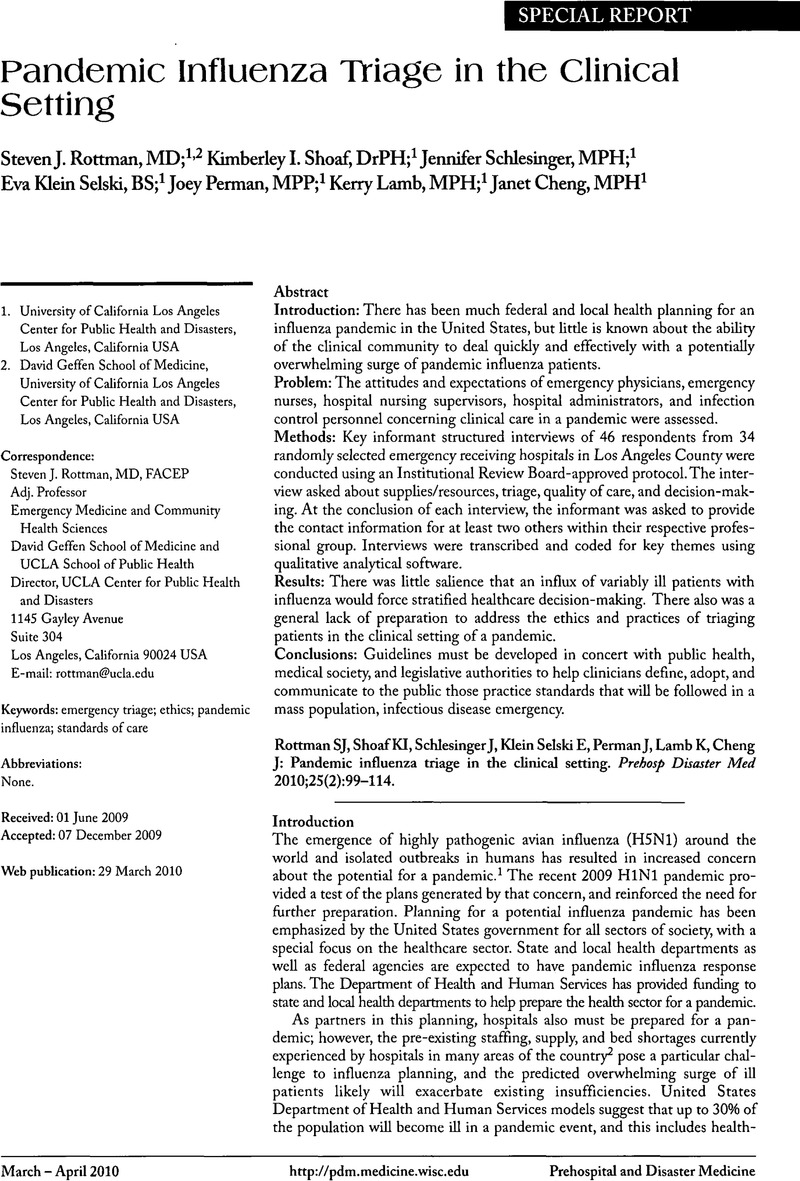No CrossRef data available.
Article contents
Editorial Comments—Pandemic Influenza Triage in the Clinical Setting
Published online by Cambridge University Press: 28 June 2012
Abstract
An abstract is not available for this content so a preview has been provided. Please use the Get access link above for information on how to access this content.

- Type
- Article Commentary
- Information
- Copyright
- Copyright © World Association for Disaster and Emergency Medicine 2010
References
1. Foltin, GM, George, L (eds): American Academy of Pediatrics: Pediatric Terrorism and Disaster Preparedness: A Resource for Pediatricians. 2006;06(07):0056.Google Scholar
2. Christian, MD, Hawryluck, L, Wax, RS, et al: Developing of a triage protocol for critical care during an influenza pandemic. CAMJ 2006;175(11):1377–1381.Google Scholar
3. Hick, JL, O'Laughlin, DT: Concept of operations for triage of mechanical ventilation in an epidemic. Acad Emerg Med 2006;13(2):223–229.10.1197/j.aem.2005.07.037CrossRefGoogle Scholar
4. Rubinson, L, Hick, JL, Curtis, JR, et al: (2008). Definite care for the critically ill during a disaster: A Framework for optimizing crtical care surge capcity: from a Task Force for Mass Critical Care summit meeting, January 26–27, 2007, Chicago, IL. Chest 133(5 Suppl):18–31.10.1378/chest.07-2690CrossRefGoogle Scholar
5. Bielajs, I, Burkle, FM Jr, Archer, FL, Smith, E: Development of prehospital, population-based triage-management protocols for pandemics. Prehosp Disaster Med 2008;23(5):420–430.10.1017/S1049023X00006154CrossRefGoogle ScholarPubMed
6. New York State Workgroup on Ventilator Allocation in an Influenza Pandemic: Allocation of Ventilators in an Influenza Pandemic: Planning Document. Albany: New York State Department of Health, 2007.Google Scholar
7. United States Department of Health and Human Services and the Centers for Disease Control and Prevention: Health Insurer Pandemic Influenza Planning Checklist, 2008
Google Scholar
8. Devereaux, AV, Dichter, JR, Christian, MD, et al: Definitive care for the critically ill during a disaster: a framework for allocation of scarce resources in mass critical care: from a Task Force for Mass Critical Care summit meeting, January 26–27, 2007, Chicago, IL. Chest 2008;133(5 Suppl):51S–66S.10.1378/chest.07-2693CrossRefGoogle ScholarPubMed
9. Atevogt, B: S. C. Guidance for Establishing Crisis Standards of Care for use in Disaster Situations: A letter Report. Institute of Medicine (IOM), Washington, DC. Sept 2009.Google Scholar
10. Upshur, RE, Faith, K, Gibson, JL, et al: Stand on Guard for Thee: Ethical Considerations in the Preparedness Planning for Pandemic Influenza. University of Toronto Joint Center for Bioethics–Pandemic Influenza Working Group, 2005.Google Scholar
11. Miller, J, Burkle, FM: Development of a Standardized Operational Framework to Guide Ethical Decisions During Pediatric Mass Critical Care. Pediatric Mass Critical Care Workgroup, Pediatr Crit Care Med, submitted to workgroup for review January 2010.Google Scholar
12. Thomas, J, MacDonald, P, Wenink, E: Ethical decision making in a crisis: A case study of ethics in public health emergencies. J Public Health Manag Pract 2009;15(2):E16–E21.10.1097/01.PHH.0000346021.06803.76CrossRefGoogle Scholar
13. Curiel, TJ: Murder or mercy? Hurricane Katrina and the need for disaster training. N Engl J Med 2006;355:2067–2069.10.1056/NEJMp068196CrossRefGoogle ScholarPubMed




